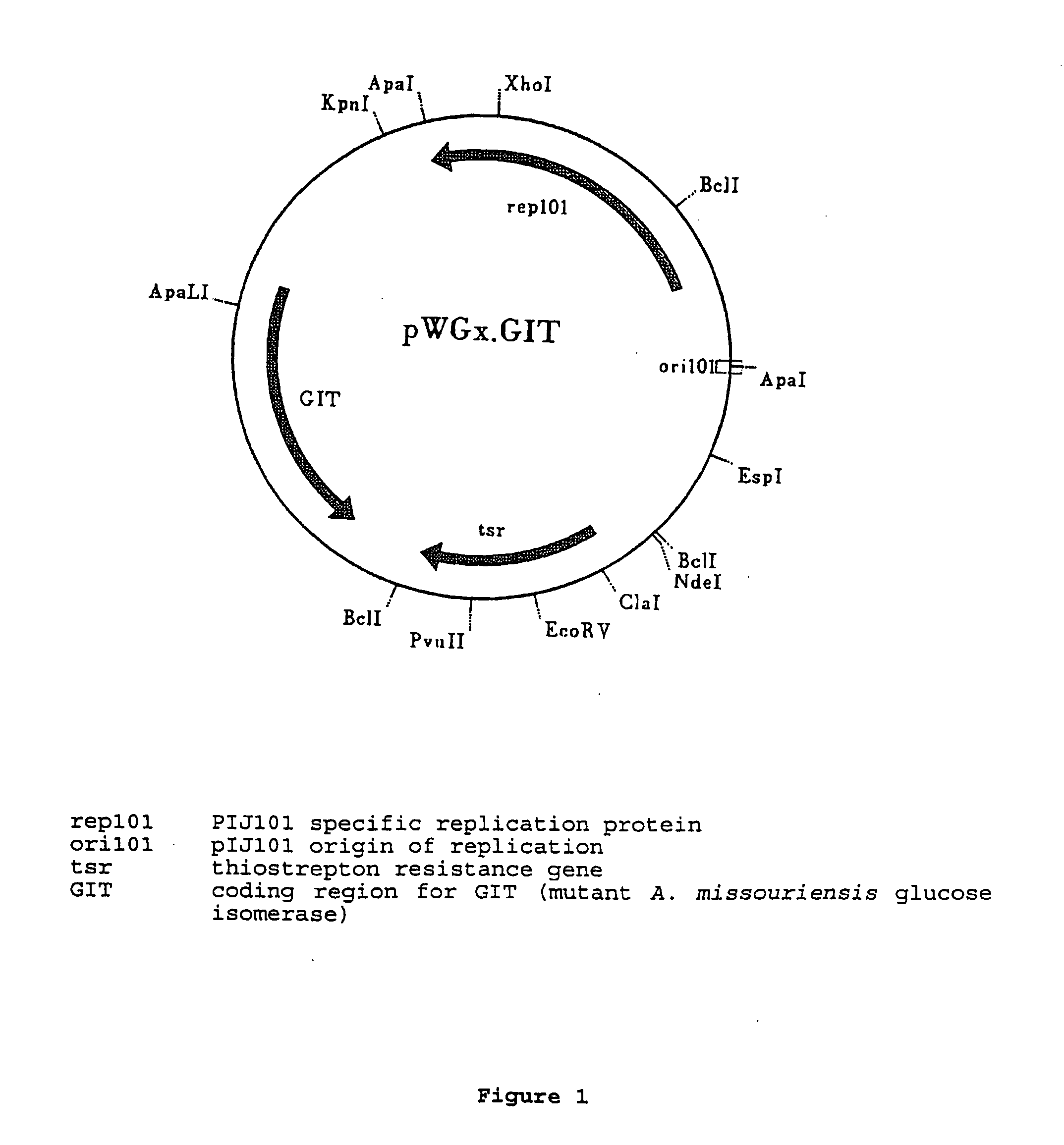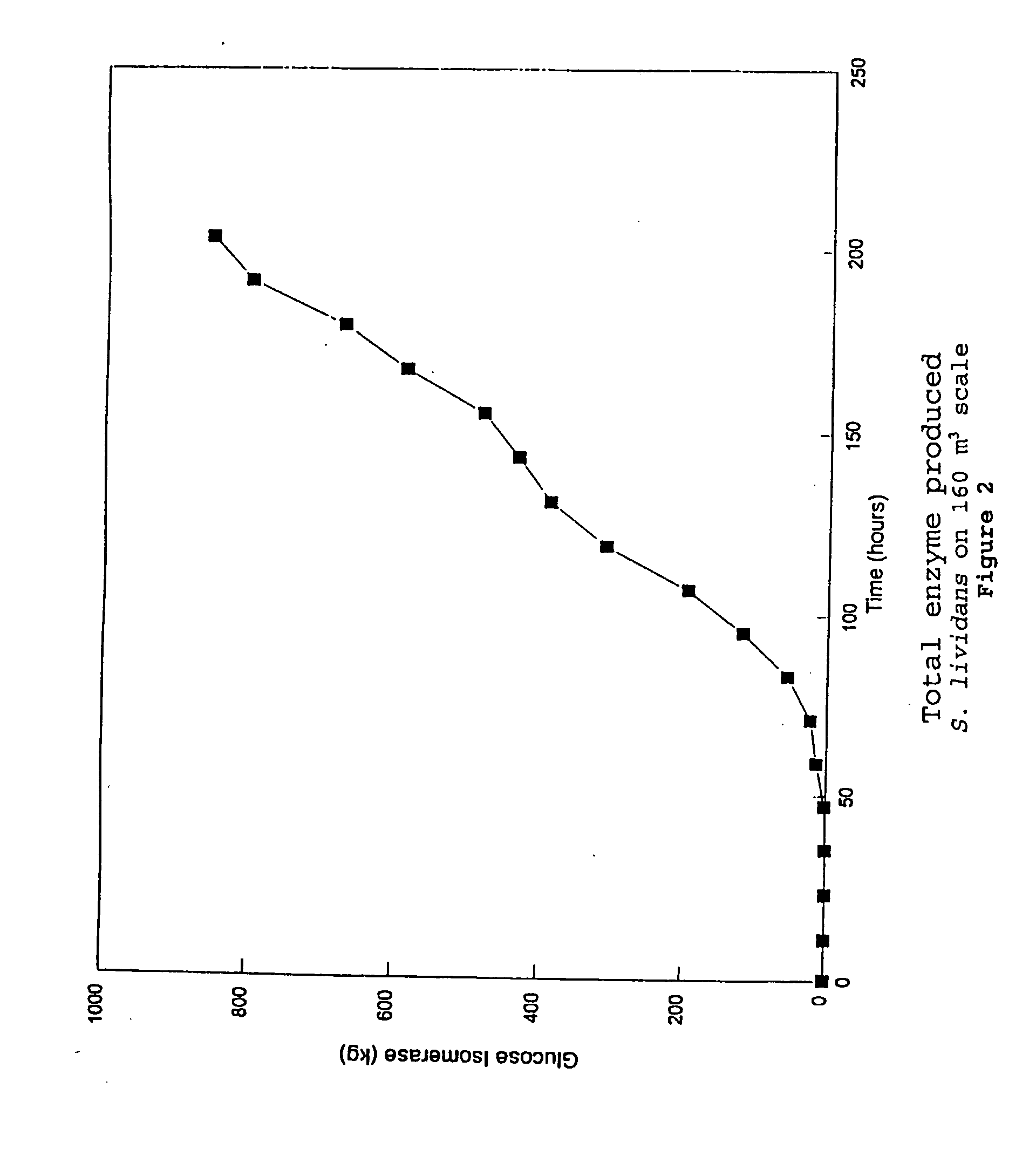Fermentative production of lipids on an industrial scale using chemically defined media
- Summary
- Abstract
- Description
- Claims
- Application Information
AI Technical Summary
Benefits of technology
Problems solved by technology
Method used
Image
Examples
example 1
Industrial Production of Glucose Isomerase Using Streptomyces lividans
Construction of a Streptomyces Strain Producing Glucose Isomerase
[0084] The glucose isomerase gene of Actinoplanes missouriensis was originally cloned as a DNA fragment of 5.0 kb in E.coli K12 strain JM101.
[0085] A 1.7 kb fragment internal to the 5.0 kb fragment, was found to represent the complete coding sequence of A. missouriensis glucose isomerase and its upstream regulatory region (see also Amore and Hollenberg (1989), Nucl. Acids Res. 17, 7515).
[0086] A glucose isomerase mutant exhibiting enhanced thermostability was obtained by changing within the glucose isomerase gene the triplet AAG encoding lysine at position 253 of the glucose isomerase protein into CGG encoding arginine (Quax et al. (1991), Bio / Technology 9, 738-742).
[0087] For cloning in Streptomyces plasmid pIJ486 (Ward et al. (1986), Mol. Gen. Genet. 203, 468-478) was used as a vector. The 1737 basepair A.missouriensis DNA fragment encoding g...
example 2
Production of Penicillin V
[0103] Conidiospores of a P. chrysogenum CBS 455.95 (or another suitable strain derived from Wisconsin 54.1255 by mutation and selection for higher productivity, preferably in the recipe as stated below) are inoculated at 10E5-10E6 conidia / ml in a production medium containing (g / l): glucose.H2O, 5; lactose.H2O, 80; (NH2)2CO, 4.5; (NH4)2SO4, 1.1; Na2SO4, 2.9; KH2PO4, 5.2; K2HPO4.3H2O, 4.8; trace elements solution (citric acid.H2O, 150; FeSO4.7H2O, 15; MgSO4.7H2O, 150; H3BO3, 0.0075; CuSO4.5H2O, 0.24; CoSO4.7H2O, 0.375; ZnSO4.7H2O, 1.5; MnSO4.H2O, 2.28; CaCl2.2H2O, 0.99), 10 (ml / l); 10% potassium phenoxyacetate solution, pH 7, 75 (ml / l). (pH before sterilization 6.5).
[0104] The culture is incubated at 25° C. in an orbital shaker at 280 rpm for 144-168 hours. At the end of the fermentation, the mycelium is removed by centrifugation or filtration and the amount quantified, and the medium is assayed for penicillin formed by HPLC methods well known in the art. ...
example 3
Large scale Penicillium Fermentation with Complex and Defined Media
[0105]Penicillium chrysogenum Wisconsin 54.1255 was optimized for growth and penicillin production on a chemically defined medium by mutation and selection on defined media as described in Example 2. Fed batch fermentations were carried out on 60 m3-scale with a complex medium as described by Hersbach at al. (Biotechnology of Industrial Antibiotics pp 45-140, Marcel Dekker Inc. 1984, Table 4, Medium B, including the salts as mentioned under Medium A) containing 50 kg / m3 Corn Steep Solids. Parallel to that, a fermentation was carried out in a defined medium as given in Example 2, where the dosages were doubled because of the high cell density character of these fed batch fermentations while lactose and ureum were omitted. Glucose was fed to the fermentor keeping the glucose concentration below 2 g / L to avoid glucose repression. Ammonium, di-ammonium-sulphate and phenyl-acetic acid were fed to the fermentor in order t...
PUM
| Property | Measurement | Unit |
|---|---|---|
| Fraction | aaaaa | aaaaa |
| Acidity | aaaaa | aaaaa |
| Strain point | aaaaa | aaaaa |
Abstract
Description
Claims
Application Information
 Login to View More
Login to View More - R&D
- Intellectual Property
- Life Sciences
- Materials
- Tech Scout
- Unparalleled Data Quality
- Higher Quality Content
- 60% Fewer Hallucinations
Browse by: Latest US Patents, China's latest patents, Technical Efficacy Thesaurus, Application Domain, Technology Topic, Popular Technical Reports.
© 2025 PatSnap. All rights reserved.Legal|Privacy policy|Modern Slavery Act Transparency Statement|Sitemap|About US| Contact US: help@patsnap.com


